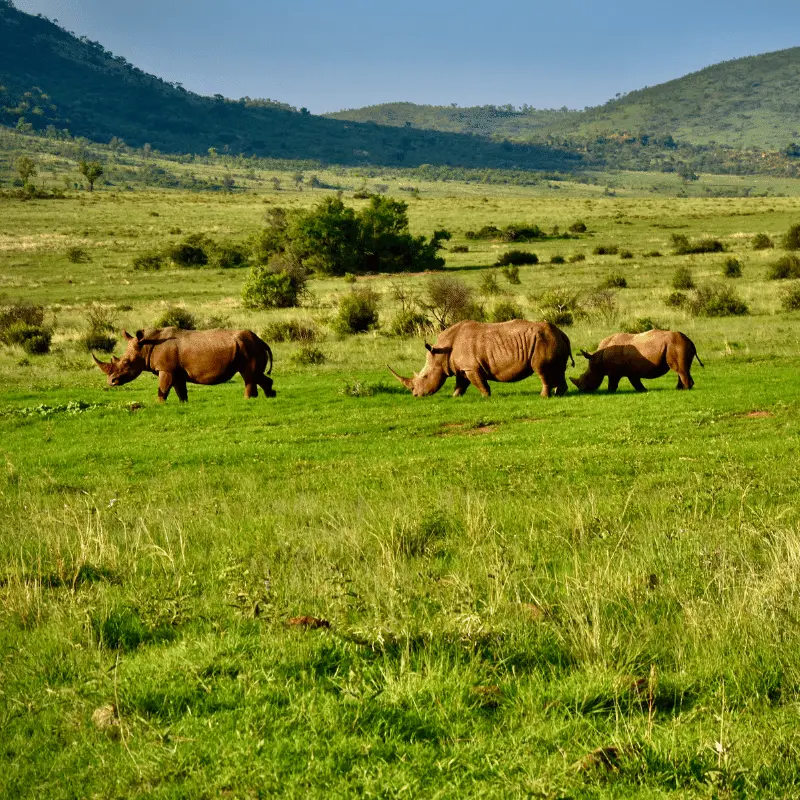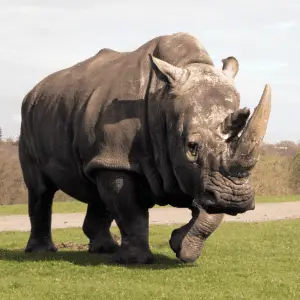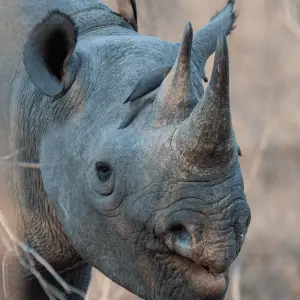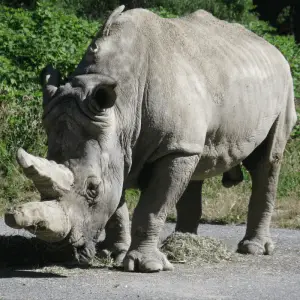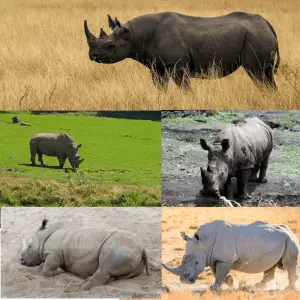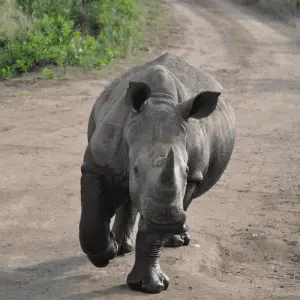The places where you can find rhinos mainly depend on their species. For example, you can discover Sumatran rhinos on the islands of Borneo and Sumatra in Indonesia. However, if you try to find a black and white rhino, you have to go to Africa. You can find rhinos in Namibia, Sumatra Borneo, Eastern Himalayas, and coastal regions of East Africa.
Rhinoceros are one of the oldest large land mammals that have been roaming on Earth. The modern rhinos of today came from a group of rhino-type mammals from over 50 million years ago. These days you can find rhinoceros in Africa and Asia only.
At the beginning of the 20th century, the population of the rhinoceros throughout the world was about half a million. However, uncontrollable poaching and habitat loss have impacted this extraordinary animal significantly.
Even though there are several conservation challenges that researchers and conservationists often face, the rhinoceros population has been growing slowly for the last few years. Right now, about 27,000 rhinoceros are living in the wild. Various international initiatives for recovering the rhinoceros population have slowly started to show great results. All five remaining rhino species have shown an upward trend in their population growth.
Location
Out of the five living species of rhinos, Two of these rhino species can be found in Africa, while the rest of the three species are found in Asia.
Among the three Asian rhino species, the great one-horned rhino is found in the Himalayan mountainous regions of Nepal and India.
The Sumatran rhino lives in Indonesia. The Javan rhinos are the most vulnerable among all the species. You can only find the Javan rhinoceros in the protected area of the island of Java in Indonesia.
The White and the black rhinoceros can be found in the wilderness of Africa.
Asian Rhino Population Status
The International Union for the Conservation of Nature has marked the one-horned rhinos as vulnerable. Right now, about 3,700 one-horned rhinoceros are left in the wild.
Only 200 individual, one-horned rhinoceros were left in the wild at the beginning of the 20th century. However, by following strict protection rules and taking severe management actions, both the Nepalese and Indian wildlife authorities have been able to bring the species back from the brink of extinction.
Right now, IUCN has marked Sumatran, Javan and black rhinoceros as critically endangered species. As we have already discussed, there are only 74 Javan rhinoceros left in the wild, which you can find only in a single protected area on the island of Java. The status of the Sumatran rhinoceros is not that good either. There are less than 80 Sumatran rhinoceros that can be found in the wild.
African Rhino Population Status
The black rhinoceros has been classified by the International Union for the Conservation of Nature as critically endangered. Recent research and data reveal that just over 6,000 black rhinos remain in the wild, whereas their counterparts, the white rhinos, have a population of roughly 18,000 individuals in their natural habitats.
What is the preferred habitat of the rhinoceros?
Preference of habitat mostly depends on the particular species of the rhinos.
For example, the Sumatran rhinoceros live in the dense tropical forests of both highland and lowland. Apart from that, you can find these rhinos in mountainous country regions, marshy areas, and places with a thick growth of bamboo and bushes.
The Javanese rhinos also tend to live in a variety of tropical Islands and lowland landscapes. You can find these rhinos living in submontane shrubs of the volcanic region of Java. However, they prefer to live in forests.
Just like their Sumatran counterparts, the Javanese rhinos also prefer to live in areas containing thick bamboo and marshy lowlands.
The greater one-horned rhinos live in the tropical and subtropical desert grassland, forests, and shrublands. They are also considered semi-aquatic animals because they love to spend their time in the swamp riversides.
Black Rhinos live in the subtropical and tropical Savanna grassland, shrublands, xeric shrublands, and deserts. Even though the habitat of these rhinos is varied, they also live in the mountain forest of high altitudes.
The white Rhinos live in the short and long grass Savanna area of Africa. Contrary to the Black rhinos, the white ones preferred grassy plains and subtropical and tropical grasslands and shrublands as their habitat.
Differences Between The Five Rhino Species
The greater one-horned rhino (Asian)
The greater one-horned rhino is considered the largest rhino species. You can identify these rhinoceros with the help of their grey-brown skin colour and a long single horn. The folds of their thick skin give these rhinoceros an armoured look.
Javan Rhino (Asian)
The Javan rhinoceros are smaller in size, and the appearance is much like the greater one-horned rhino, but with more minor folds in the skin and a slightly smaller head in comparison with the body.
Sumatran Rhino (Asian)
Among all the five species of rhinoceros, the Sumatran rhino is the smallest one. The Sumatran rhinoceros is reddish-brown, and it is the only Asian rhinoceros species that has two horns. Their skin colour is also very different from the other two Asian rhinoceros species.
African Rhinos (Black And White)
Between the two African rhinoceros species, the black Rhinos are the smaller ones. Both the White and the black rhinoceros have two horns. That means you cannot differentiate these rhino species with the help of their number of horns.
However, the characteristic features of these two rhinoceros are significantly different from each other.
One of the easiest ways to differentiate between these two species is by checking out the shape of their mouth.
The white rhinos are primarily grazers, and they have a more squarish upper lip.
Compared to that, the black rhinos, noted for their browsing behaviour, have hook-shaped upper lips.
So, if you check out the lip structure of the African rhinoceros carefully, you will be able to point out which of these two species the animal belongs to.
What are the biggest threats to the rhinoceros?
Poaching, degradation of habitat, and loss of habitat are the most significant reasons Asian and African rhinoceroses are being threatened.
Even though there has been a strict ban on the international trade of rhinoceros horn since 1977, the illegal market is still thriving with these band products. The demand for illegally acquired rhinoceros horns is on the rise in the Asian market.
Apart from these issues, the Sumatran rhinoceros faces another problem which is isolation. In the Sumatran wild, there are less than 80 rhinoceroses left. That makes the population way too scattered for the animals to find their mates for breeding.
Rhinoceros Are Crucial For The Environment
Like the elephants, rhinoceroses are also considered the engineers of an entire ecosystem in the places they live. For example, the greater one-horned rhinos live in the grasslands of Asia, where access to water is not that difficult. The rhinos residing in these areas help to maintain the health of the water holes and the grasslands. That enables The other herbivores living in the area to feed on healthy and better-quality vegetation when they share the area with rhinos.
Although only small animals can benefit from this since the rhinos are highly territorial animals, dominant male rhinos especially do not allow any animals or other rhinos to encroach on their land.
However, they do not mind the smaller herbivores feeding on their territory. Rhinoceroses also help to disperse seeds of various fruits and plants they have eaten through their excrement.
Why Are Rhino Horns So Popular To Humans?
The rhinoceros horns are not at all beneficial for humans. However, in some traditional Asian medicines, rhino horns are often used. Rhino horns are often ground up and mixed with other elements to create medicine. It is said that this kind of medicine can cure a wide range of ailments, including cancer. However, this is all speculation and unproven and, more than likely, not authentic.
Some people often use rhino horns to showcase their wealth and status to others. Even though awareness programs have been put in place rigorously to make people aware of the fruitless usage of rhino horns in traditional medicines, the same demands continue to grow in countries like Vietnam and China. That is what is keeping the rhino horn poaching industry alive despite the strict international ban on such trade.
Right now, it is the purchase that creates a significant threat to the rhinoceros. In 2018, 769 rhinoceroses were poached in South Africa. The poaching of the rhinoceros depends on the demand for their horns. For example, as there is no demand for the horn of the Java rhinoceros species, they are not targeted by the poachers anymore. For the last 25 years, not a single Javan rhino has been killed by the illegal Hunters.
Poaching Damage
Poachers killed between the dates of 1960 and 1995 98% of the black rhinos. This abrupt surge in poaching is directly proportional to the politics of China.
During this time, the Chinese leaders have significantly promoted traditional Chinese medicines that use rhinoceros horn as an ingredient.
Primarily as there were no strict rules against poaching of rhinos, the numbers skyrocketed quickly.
However, after leaders implemented the international ban, the rhinoceros horn trade significantly slowed down in China.
However, in the last few years, the demand for rhinoceros horns in Vietnam has led to poaching spikes.
What are rhino horns made of?
The rhino horn is made of keratin, the same substance that creates human nails and hair. Rhino babies do not have any horns right after they are born. But, within a couple of months, they tend to develop a small stab that keeps on growing throughout their life.
Recommended Read: Rhino Pregnancy
Extinct Rhino Species
Even though the modern rhinoceros species face significant challenges, none of them has gone extinct to date. However, several subspecies of rhinoceroses have become extinct in recent years. Previously, there were three different subspecies of the Javan rhinoceros, but, right now, you can find only one of them. The last Vietnamese Javan rhinoceros was killed in 2010.
These Sumatran rhino subspecies in Malaysia were declared extinct in 2019 when the last surviving female and male died. After the last surviving male rhinoceros died in 2018, the northern white rhinoceros was declared functionally extinct.
In 2011, the Western black rhinoceros subspecies was declared extinct as there were no sightings of the subspecies since 2001. Apart from the extinction of these rhino subspecies, the last rhino species that have gone extinct is the woolly rhinoceros. The researchers believe that this species was extinct around 8000 BC.
Predators Of Rhinos
As the rhinoceros is one of the largest land animals, they face only a couple of predators in the wild. The thick skin of the adult rhinoceros gives them a unique look and serves as body armour. That is why most of the existing land predators do not try to attack fully grown adult rhinoceros. However, rhino babies are attacked by predators like jaguars, lions, and crocodiles as they haven’t yet developed the hard body armour like the adults.
Rhinos are fascinating animals, and they need our protection.

